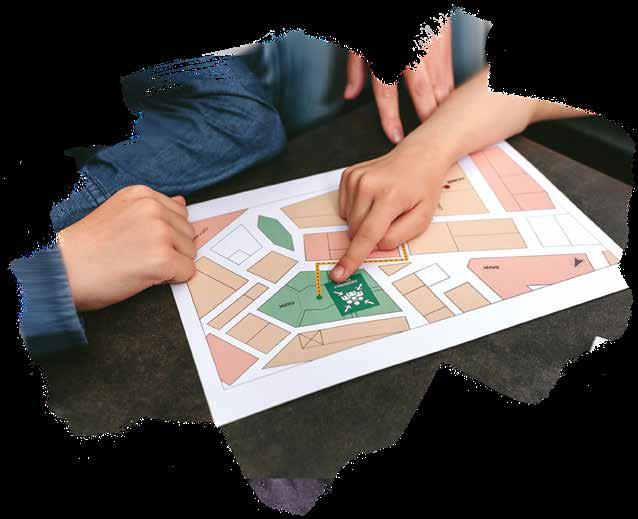
8 minute read
PREPARATION IS KEY
TEXT AND IMPORTANT ELEMENTS SHOULD BE KEPT WITHIN THIS AREA
Work as a “family team” to utilize this handbook and construct your own Family Disaster Plan. Once the plan has been assembled, build the “Survival Kit” (described on page 37) and rehearse your family preparedness plan. Make sure everyone in your family understands the plan completely and knows exactly what to do. Once you have completed the preparations, keep the document in a safe place where it will be easy to find during hurricane season.
In any kind of emergency — especially one involving an approaching hurricane — advance planning and preparation are the keys to weathering the storm safely.
The first step toward building your Family Disaster Plan is to consider what preparations can be done before hurricane season to alleviate stress once the season begins. Use this checklist to get your pre-hurricaneseason preparations underway.
Insurance Inventory
Inventory information should include values for each insured item as well as date of purchase and serial number. Having the appropriate insurance will help you minimize your losses. Ask your insurance agent to review your current policy.
There are four types of property insurance on the market today:
HOMEOWNERS INSURANCE: This type of insurance usually covers losses caused by winds, storms and broken water pipes. However, flooding is not covered. It may be a good time to review what your policy covers.
WIND AND HAIL INSURANCE: This type of insurance covers losses due to storm winds in coastal areas. It is an underwritten policy provided by insurance providers when it is not included in the basic homeowners policy.

FLOOD INSURANCE: This type of policy is underwritten by the National Flood Insurance Program. The policy is available in those communities that adopt and enforce flood plain management regulations.
RENTERS INSURANCE: Both property protection insurance and flood insurance for contents are available for those who live in rental units. Contact your insurance agent for details.
Important note: there may be a waiting period before your policy is activated. Contact your insurance agent for details.
Important Papers Inventory
Gather copies of your family’s important paperwork, and store them in a secure location that will be well within reach if you have to locate them quickly because of an approaching storm. Consider including copies of the following for each family member:
• Social Security Cards/Visas
• Passports
• Driver’s license
• Vehicle registration and proof of insurance
• Local map
• Wills, deeds and powers of attorney
• Insurance policies (life, health and property)
• Medical and vaccination records, including medicine or food allergies and other specific health conditions
• Copies of prescription medicine labels
• Birth and marriage certificates
• Tax or other important business and personal records
• Emergency contact list and phone numbers
• Veterinary and vaccination records for pets
Family Preparedness Plans
You’ve already taken the first step toward additional disaster planning by acquiring a copy of the Osceola Hurricane Handbook — now it’s time to put the handbook to good use by completing your Family Disaster Plan (see page 15). Use this checklist to assist you with:
Text And Important Elements Should Be Kept Within This Area

FINANCIAL PLANNING: You should be prepared to sustain yourself and your family away from your home for several days, keeping in mind it could be several weeks. Government agencies may not be able to react with assistance as quickly as you think they can. The following breakdown will give you an idea of expenses for a family of four with one of the four having “special needs” requirements.
PROPERTY INVENTORY: Create a thorough inventory of your property and possessions using photographs, video and/or manual records.
INDOOR SAFETY PLAN: Anything that can move, fall, break or cause a fire is a hazard during a hurricane. An indoor home inspection and teaching responsible family members how to cut off utility connections at the source will minimize potential problems and hazards.
OUTDOOR SAFETY PLAN: An inventory of small outdoor items such as toys, potted plants and lawn furniture should be made. Give family members responsibility for knowing their locations as well as how and where to secure them.
CARING FOR TREES: To increase storm resistance of trees, they need to be checked yearly and pruned if necessary by an insured, licensed and qualified International Society of Arboriculture Certified Arborist. Call UF IFAS Extension in Osceola County at 321-697-3000 or visit www.treesaregood.org for a list of arborists.
DISASTER SUPPLIES KIT: Water, food, first aid kit, clothing, bedding, tools and special needs items. $100 or more. (In addition to items you may already have; see page 37.)
HOME AND PROPERTY PREPARATION: The estimated cost of securing a 1,400 sq. ft. home with 11 to 13 openings requiring 5/8" plywood, visqueen, screws, duct tape, etc., $250 to $350.
• Prepare your property by keeping ditches, ponds, inlets and swales free of debris and report clogs.
• Prevent flooding at your home by using storm-proofing measures and elevate utilities on the property.
EVACUATION EXPENSES: These expenses include fuel expense, restaurant expense and your stay in hotels. The average hotel night is $120. Add to that the fuel and eating expense, and you may need to budget $220 per day.
PET BOARDING: Average boarding costs, depending on the animal, are $20 to $35 per night.
PRESCRIPTION MEDICINES: You should budget enough money to pay for a one-month supply.
CASH ON HAND: During a disaster, credit and bank card use may be limited due to loss of power. The amount of cash you have on hand should be determined by what you believe your needs will be.
Keep a large supply of fresh batteries on hand to operate radios and other emergency equiptment for several days.
Tips For Emergency Storage
• Store emergency supplies in airtight plastic bags. Keep a supply on hand to use throughout your hurricane preparations.
• Have enough waterproof containers, such as plastic bins or buckets, to store last-minute items such as clothing, evacuation supplies, groceries and more.

• Re-evaluate your “Survival Kit” at least once a year to confirm it still meets your family’s needs.
• Replace batteries according to expiration dates recommended by manufacturer. Check at least every six months, and keep a large enough supply of fresh batteries on hand to operate radios and other emergency equipment for several days.

• Re-evaluate all clothing items, rain gear, sleeping bags and similar supplies every six months.
• Ask your pharmacist how long prescriptions may be stored and make arrangements.

Here are a few tips to help you complete those last-minute details once a tropical storm or hurricane watch has been issued:
• Check food, water, first aid, batteries, pet and other stored supplies to make sure they are fresh, adequate and ready to use.
• Start a “last-minute” shopping list for any items you may need and pick them up as soon as possible.
• Fill your car with gas; check oil, tires and other maintenance points.
• If you plan to evacuate, place items you’ll need in your car.
• Complete any laundry or other household chores to ensure your family will be more comfortable if you have to spend time at home without electricity.
• Pick up loose items around your property and store them until after the storm passes.
• Check the tools and supplies you’ll need to secure windows, doors and other storm-vulnerable areas.
• Make sure your generator, if you plan to use one, is ready with gas, oil and a safe location for operation.
• Update your family’s emergency phone list if necessary.
• Contact your doctor, veterinarian, dentist or pharmacist to arrange for any extra prescriptions or other medications you need to have on hand.
• Once a hurricane “Warning” has been issued for Osceola County, check with your local government on their sandbag distribution policy and locations.
Preparation Pays Off
By the time a tropical storm or hurricane warning is issued for our area, options for dealing with the storm will be limited to two fundamental choices — remaining in a secured, prepared home or evacuating. Use these guidelines for last-minute preparations involving either of those choices.
If You Stay Home
Secure Your Home And Property
The most susceptible areas of your home are the exterior windows, glass doors, garage doors and roof and gable ends. If hurricane winds enter any of these openings, increased internal pressure and uplifting on walls and roof supports can cause major damage. Address any danger areas early in the season, so you can be ready to take action quickly when a storm approaches.
• Secure your home and property to protect it from hurricane-related damage. This includes boarding up windows, securing all doors, including the garage door, turning off power at the source, etc.
• Make sure all family members and pets are safely indoors, and that they stay there until the danger has passed.
• Make sure your vehicle is parked in the safest possible location to minimize storm-related damage.
• Continue monitoring local news and weather updates.
• Keep in touch with friends and family during the storm to let them know how you’re faring.

Exterior Windows
The most secure coverings for windows are shutters. If there are no shutters on your home, temporary coverings can be made of 5/8" plywood that must be installed with a 4" overlap on all sides. The plywood should be bolted to the house. This procedure will ensure it will stay in place and not become detached during a hurricane.
Large Windows And Glass Doors
Reinforcement of plywood over large windows and glass doors can be accomplished by bolting a two-by-four support beam across the plywood and angling another two-by-four beam from that beam to an anchor that has been firmly set in the ground.
Garage Doors
Garage doors can be reinforced by adding horizontal bracing to each panel at its weakest point. Kits are available at your local home improvement center.
Roof Gable Ends

Hurricane force winds can cause damage by lifting off the roof when entering unsecured openings of roof gable ends. Use the same temporary shutter procedures for exterior windows to cover the openings in this area.
Roof Protection
Hurricane straps can increase the strength of your roof against the uplifting forces of hurricane winds by 50 to 75 percent. They are galvanized metal bracing materials designed to hold the roof joist to the top plate and reinforce the bonding strength beyond that of regular nails. Retrofitting your home with these straps is not considered a “do-it-yourself” project. A professional should be contracted.
WIND-BLOWN DEBRIS
Check around the yard for loose objects, such as toys, gardening tools, barbecue equipment, lawn chairs and other items that could cause damage if blown around. Have a “cleanup drill” to practice gathering these items quickly and putting them in a safe location.
If You Evacuate
• Secure your home and property to protect it from hurricane-related damage. This includes boarding up windows, turning off power at the source, etc.
• Continue monitoring local news and weather updates.
• Let your family, friends and neighbors know where you will be, how you can be reached and when you plan to return home.
• Leave the area as soon as possible to help minimize traffic delays along evacuation routes. Plan to leave early and allow extra driving time.
• Once you arrive at your destination outside the risk area, call to let your loved ones know you have arrived safely. Plan to stay until local officials give the “all-clear” for returning home.
Keep Cash
After a disaster, you may need cash for the first few days, or even weeks. Income may stop if you can’t work. To help stay solvent, consider keeping a small amount of cash or traveler’s checks at home in a place where you can get at it quickly in case of a sudden evacuation. A disaster can shut down local ATMs and banks.








